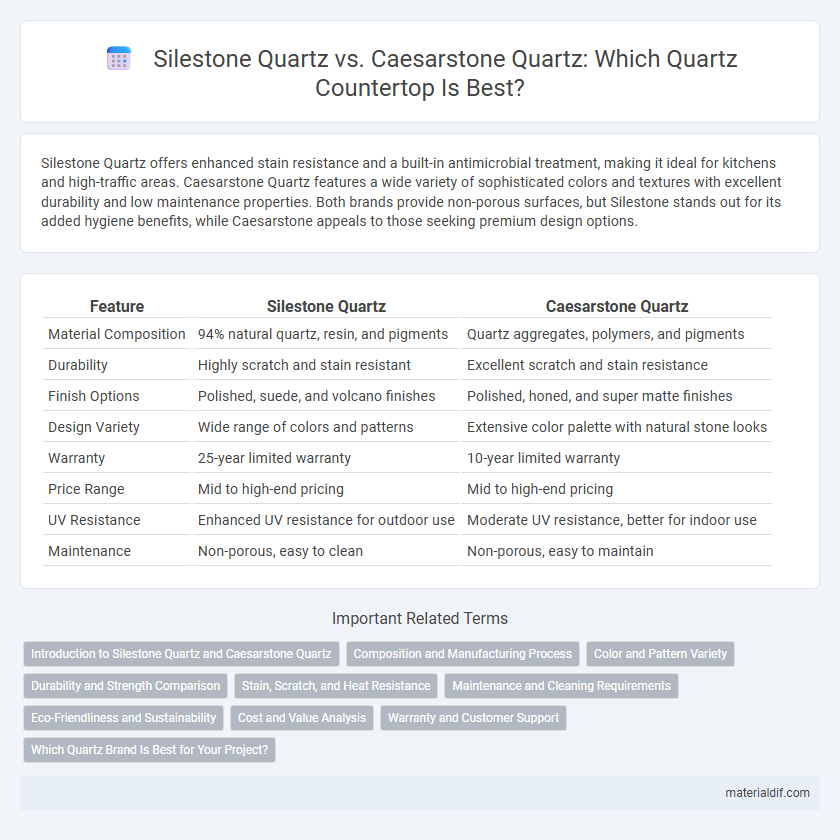Silestone Quartz offers enhanced stain resistance and a built-in antimicrobial treatment, making it ideal for kitchens and high-traffic areas. Caesarstone Quartz features a wide variety of sophisticated colors and textures with excellent durability and low maintenance properties. Both brands provide non-porous surfaces, but Silestone stands out for its added hygiene benefits, while Caesarstone appeals to those seeking premium design options.
Table of Comparison
| Feature | Silestone Quartz | Caesarstone Quartz |
|---|---|---|
| Material Composition | 94% natural quartz, resin, and pigments | Quartz aggregates, polymers, and pigments |
| Durability | Highly scratch and stain resistant | Excellent scratch and stain resistance |
| Finish Options | Polished, suede, and volcano finishes | Polished, honed, and super matte finishes |
| Design Variety | Wide range of colors and patterns | Extensive color palette with natural stone looks |
| Warranty | 25-year limited warranty | 10-year limited warranty |
| Price Range | Mid to high-end pricing | Mid to high-end pricing |
| UV Resistance | Enhanced UV resistance for outdoor use | Moderate UV resistance, better for indoor use |
| Maintenance | Non-porous, easy to clean | Non-porous, easy to maintain |
Introduction to Silestone Quartz and Caesarstone Quartz
Silestone Quartz, manufactured by Cosentino, is known for its high durability, wide color range, and integrated antimicrobial protection, making it a popular choice for kitchen countertops and surfaces. Caesarstone Quartz, produced by an Australian company, offers a blend of natural quartz with advanced resin binders, praised for its scratch resistance, low maintenance, and contemporary designs. Both brands represent premium quartz surfaces with distinct manufacturing processes and unique aesthetics suited for residential and commercial applications.
Composition and Manufacturing Process
Silestone quartz surfaces comprise approximately 94% natural quartz combined with a proprietary blend of polymers and resins, utilizing a unique N-hi-tech manufacturing process that enhances durability and stain resistance. Caesarstone quartz is made from roughly 90% natural quartz, mixed with high-performance resins and pigments, created through a Vibrating Compaction Process that ensures density and structural integrity. Both brands use advanced manufacturing technologies to produce engineered stone with superior hardness and low porosity, ideal for kitchen and bathroom applications.
Color and Pattern Variety
Silestone Quartz offers an extensive palette with over 90 colors and a diverse range of patterns, including unique textures and finishes inspired by natural stone. Caesarstone Quartz provides around 50 color options, emphasizing consistency and subtle patterns that mimic natural variations in materials like marble and granite. Both brands deliver high-quality quartz surfaces, but Silestone stands out for broader color variety, while Caesarstone is preferred for its elegant, understated pattern designs.
Durability and Strength Comparison
Silestone Quartz features enhanced durability due to its proprietary Triton technology, which increases scratch and stain resistance, making it highly suitable for kitchen countertops. Caesarstone Quartz is known for its high-strength composition, incorporating quartz particles binding with resins that provide excellent impact resistance and long-term structural stability. Both brands offer superior toughness, but Silestone excels in scratch resistance while Caesarstone is often preferred for its robustness under heavy use.
Stain, Scratch, and Heat Resistance
Silestone Quartz offers superior stain resistance due to its proprietary HybriQ+ technology, making it highly durable against common household stains compared to Caesarstone Quartz. In terms of scratch resistance, both Silestone and Caesarstone provide robust surfaces, but Silestone's enhanced resin composition slightly outperforms in resisting abrasions from daily use. Heat resistance is comparable in both brands; however, users should avoid placing hot pots directly on either surface to prevent potential damage and preserve longevity.
Maintenance and Cleaning Requirements
Silestone quartz requires routine cleaning with mild soap and water, and its Microban protection reduces bacterial growth, making maintenance easier. Caesarstone quartz also demands regular cleaning with non-abrasive household cleaners, but it may need immediate attention to prevent staining from acidic substances. Both brands resist scratches and stains well, yet Silestone's antimicrobial feature offers an added advantage for low-maintenance upkeep.
Eco-Friendliness and Sustainability
Silestone Quartz incorporates Eco-Friendly HybriQ+ technology, reducing water consumption and waste during production, while also using recycled materials to promote sustainability. Caesarstone Quartz emphasizes sustainable manufacturing with strict waste management, water recycling, and energy efficiency but uses less recycled content compared to Silestone. Both brands meet high environmental standards, yet Silestone's focus on recycled content and reduced environmental impact establishes a stronger leadership in eco-friendly quartz surfaces.
Cost and Value Analysis
Silestone Quartz typically ranges from $50 to $70 per square foot, offering a balance of durability and affordability with integrated antimicrobial properties that enhance long-term value. Caesarstone Quartz, priced between $55 and $85 per square foot, is renowned for its premium aesthetic options and high scratch resistance, justifying its higher cost with superior durability and design versatility. Both brands provide strong warranties, but Silestone's cost-effectiveness suits budget-conscious renovations, while Caesarstone appeals to those prioritizing luxury and extended lifespan in quartz surfaces.
Warranty and Customer Support
Silestone Quartz offers a 25-year limited warranty that covers material defects and includes comprehensive customer support with nationwide service centers and easy claim processes. Caesarstone Quartz provides a similar 25-year warranty emphasizing stain and scratch resistance, backed by a robust customer service team known for responsive support and detailed product guidance. Both brands prioritize long-term coverage and dedicated assistance, ensuring durable performance and customer satisfaction.
Which Quartz Brand Is Best for Your Project?
Silestone Quartz offers superior stain and scratch resistance with patented Microban antimicrobial protection, making it ideal for high-traffic kitchen surfaces. Caesarstone Quartz features a wide range of unique colors and patterns with high durability suited for both residential and commercial projects. Choose Silestone for advanced hygiene and durability, or select Caesarstone for exceptional design variety and robust performance.
Silestone Quartz vs Caesarstone Quartz Infographic

 materialdif.com
materialdif.com